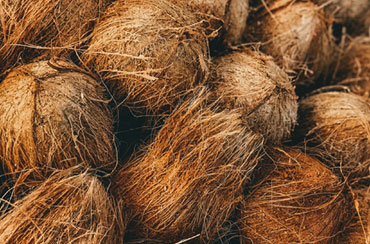Coco Coir Production and Quality
Buffered vs Unbuffered Coco Coir
The use of the coco coir soil less substrate has grown significantly in recent decades. With numerous options available, one aspect stands out: buffered vs unbuffered. This post will illustrate the differences, benefits, and drawbacks of each.
Coco Coir – (In) a Nutshell
Coco coir is the exterior shell (typically referred to as the husk) of the coconut. Until relatively recently it was regarded as a useless byproduct of the coconut industry, was discarded, and sat unused. That is until growers realized these piles of material had several characteristics which make it an ideal substrate:
- high cation exchange capacity (efficient use of fertilizer)
- naturally occurring trichoderma (beneficial bacteria)
- hydroscopic water-wicking ability (acts like a sponge)
- easily compressed and expanded (save on shipping costs and storage space)
Salinity Concerns
Most coco coir comes from coastal areas and may have high levels of NaCl. Excess Sodium (Na) and Chlorine (Cl) cations lead to salt stress in plants with harmful results. The stress begins manifesting as phytotoxicity, and if not mitigated will lead to extensive crop damage or even loss. Most manufacturers offset this by buffering coco coir with calcium nitrate. This achieves two things: it purges the NaCl and adds calcium, one of the main elements necessary for plant growth. This is typically achieved by soaking massive amounts of raw coconut cost with a high EC solution of calcium nitrate. While this achieves the desired result it also leads to multiple problems.
The Industrial Buffering Processes
Most coco coir manufacturers soak the raw, unbuffered media in calcium nitrate for weeks, or months, at a time. The excess runoff then leaches into nearby bodies of water – water sources which Indian and Indonesian indigenous communities depend upon. Some coco coir manufacturers allow the NaCl to leach in a slightly more sustainable fashion by leaving their coconut coir exposed for months to the seasonal rains. Unfortunately, as demand for coco coir grows, producers are adopting buffering practices in order to keep up with their production schedules. This is creating significant impacts to the population, the environment, and on the quality of the coir itself. Industrial buffering of coco coir leads to a breakdown of the natural lignins at a microscopic level. This creates a substrate with a lower air-filled porosity, a reduction in the lateral capillary movement of water, and an overall decrease in available water.
Washed vs Buffered
By comparison, the environmental impact of unbuffered coco coir production is relatively insignificant. It is either left completely unwashed, or is washed 1-5x times depending on the desired EC level. While this practice is unfeasible for manufacturers sourcing their coconuts from coastal areas, RIOCOCO maintains a network of inland coconut groves to provide raw materials with negligible levels of NaCl. Any excess NaCl anions can be removed with our proprietary MAXXWASHED process, and the EC level of the finished coco can be set to the individual specifications of the client.
How to Buffer Coco Coir
At the beginning of crop production there are some best practices to follow in order to maximize the substrate fertility for increased growth rates and yield. Compressed blocks should expanded with a 2.0 EC calcium nitrate solution with the ph adjusted to 5.8. Once expanded, prepare a vegetative solution with an EC of 2.5 – 3.0 and a pH of 5.8 (if possible, maintain a N:Ca ratio of ~1:1). This will allow the Ca+ cations to bond with the cocos cation exchange sites while still leaving plenty available for uptake by the plant roots. The vegetative solution is then flushed through the bags and the the new clones can be transplanted. Please check how to buffer coco coir in depth guide for further details.
Monitoring Calcium Levels
A simple way to monitor calcium levels is by periodically collecting samples of the irrigation runoff and measuring its EC. Note that his isn’t necessarily to most accurate way to determine precise EC levels of the substrate itself. Leachate EC does, however, give a clear indicator that additional calcium nitrate may be needed in the nutrient solution. If the EC of the runoff is lower than the nutrient solution, growers should incrementally add more calcium to the solution (ie. 10% at a time) until the EC of the runoff is no longer lower.
Unbuffered Coir – The Growers Choice
For decades buffered coir has been used in fruit, vegetable, and cut flower production. As demand grows, outmoded practices are having a detrimental impact on flora and fauna in manufacturing regions. The resulting product is not only detrimental to the environment, its inconsistent quality has a detrimental economic impact on the grower. RIOCOCO ethically manufactures the highest quality unbuffered coco coir on the market.

